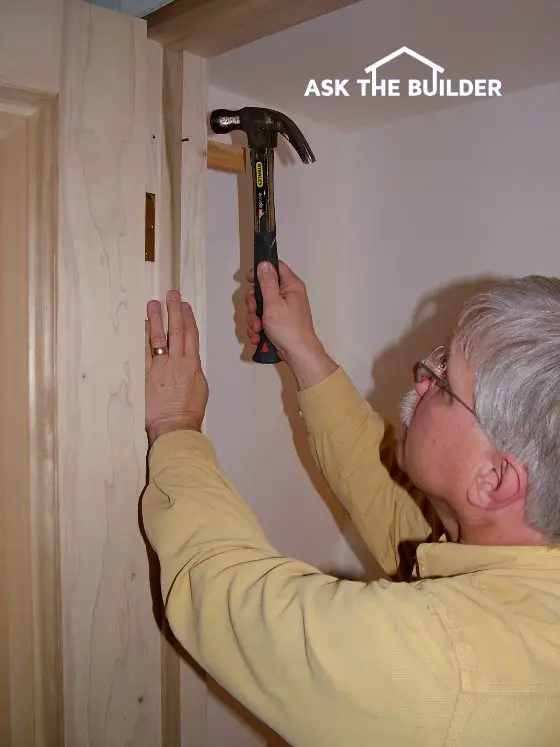
Hanging a prehung door is not too hard. It requires attention to detail. (C) Copyright 2018 Tim Carter
Easy Fence Posts
Question #1: Tim, what can you share about installing fence posts? My online research has me more confused than ever. Quite a few websites talk about putting concrete around each fence post. Is this a good idea? Are there other options? How deep should fence posts be? I don’t want to waste time nor money. Ken S., Tulsa, OK
Have you run into lots of conflicting information at various websites? I know I have. The reason this happens, I feel, is because the barrier to publishing your opinion is now lower than a limbo stick for ants.
Before the Internet, book and magazine publishers would do a good vetting process to see if the author was an authority. Now that vetting job is on your shoulders and most are not willing to see if the online material has been created by someone who has done the job for years in a professional capacity.
In my opinion, the advice offered by those promoting concrete is ill-advised. I prefer to look at the way ranchers and farmers install fence posts as my north star. If they do use concrete, it’s often only at corner posts and around gate posts in a fence line.
If you have strong soil, the compacted soil will do a remarkable job of supporting a fence post. As you install the soil around the post, just add four inches of soil at a time and compact it using a 2x4 as a tamping tool.
You can use crushed gravel around fence posts too. It’s important to realize the gravel should have an assortment of sizes including fines. Fines are sand-sized crushed rock and the resulting dust from the crushing process. This fine material helps interlock the larger pieces of angular gravel with one another.
Crushed gravel, once it’s compacted and damp, is nearly as strong as concrete. The advantage over concrete is that if you have to remove the fence post, you can remove the gravel with far less effort than if you had to break apart the concrete around a fence post.
The depth of fence posts is important. Shallow fence posts allow you to tip over a fence with ease. If you live in a windy area, your fence could blow over!
I’ve had the best luck installing fence posts about 2-feet deep. This works well for a standard 4 to 6-foot-tall fence. If you plan to have a tall fence over 6 feet, then you might want to have your post extend 30 inches below the surface.
Be sure to call 811 if you intend to dig fence post holes. There might be all sorts of underground utilities in your yard and the last thing you want to do is cut a power or communications cable. Puncturing a gas or water line might also ruin your day.
I’ve got all sorts of extra fence post tips and videos at my website waiting for you. Just go to: fencepost
Hanging a Door
Question #2: Oh do I need your help, Tim. I purchased a prehung interior door and now need to install it. I thought it would be easy to do, but I’ve discovered it does seem to take some skill and magic. What can you share with me to get me out of this pickle? I’ll be appreciative of any advice. Brad G., Clemson, SC
Admit it. How many times have you jumped into a job like Brad and started to flounder? It happened to me countless times early in my building career, but I enjoyed challenging myself. You may only have the weekend to get something done and challenges can quickly transform into disasters.
There are lots of steps to hang a prehung door. It’s important to realize that the rough opening needs to be about one-half to 1-inch wider than the outer width of the door frame. You need this wiggle room to be able to install wedge-shaped shims.
The goal is to have a consistent gap between the door and the door frame. This gap is usually 1/8th inch. The hardest part for most rookies is getting the gap along the top of the door to be the same. One, or both, of the side jambs usually need to be cut off to get the top gap perfect.
Be sure to install the shims behind the door hinges. The most important step after the door is installed is to install a 2.5-inch, or 3-inch, screw in one of the screw holes of the top hinge. This screw needs to penetrate through the door jamb and embed itself into the rough lumber of the wall. This screw ensures the door will not droop over time causing it to rub against the jamb.
I’ve got great detailed step-by-step tips and videos for installing a prehung door at my website. Go to: installprehungdoor
Column 1259
The post Easy Fence Posts and Hanging a Door appeared first on Ask the Builder.
Via Interior http://www.rssmix.com/
No comments:
Post a Comment